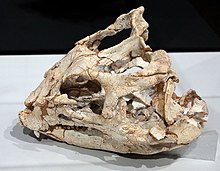Yinlong downsi
|
Yinlong Temporal range: Late Jurassic, 158 Ma |
|
|---|---|
 |
|
| Fossil skull | |
| Scientific classification | |
| Kingdom: | Animalia |
| Phylum: | Chordata |
| Class: | Reptilia |
| Clade: | Dinosauria |
| Order: | †Ornithischia |
| Genus: |
†Yinlong Xu et al., 2006 |
| Species: | †Y. downsi |
| Binomial name | |
|
Yinlong downsi Xu et al., 2006 |
|
Yinlong (meaning "hidden dragon") is a genus of basal ceratopsian dinosaur from the Late Jurassic Period of central Asia. It was a small, primarily bipedal herbivore.Yinlong is the oldest and most primitive ceratopsian known.
Yinlong was a relatively small dinosaur, with a total length of about 1.2 metres (3.9 ft) from nose to tail, and a weight of about 15 kilograms (33 lb). Long robust hindlimbs and shorter slender forelimbs with three-fingered hands suggests a bipedal lifestyle like many small ornithopods.
Despite a virtually frill-less and totally horn-less skull, Yinlong is a ceratopsian. Its skull is deep and wide and relatively large compared to most ornithischians, but also proportionately smaller than most other ceratopsians.
A coalition of American and Chinese paleontologists, including Xu Xing, Catherine Forster, Jim Clark, and Mo Jinyou, described and named Yinlong in 2006. The generic name is derived from the Mandarin Chinese words 隱 (yǐn: "hidden") and 龍 (lóng: "dragon"), a reference to the movie Crouching Tiger, Hidden Dragon, large portions of which were filmed in the western Chinese province of Xinjiang, near the locality where this animal's fossil remains were discovered. Long is the word most often used in the Chinese media when referring to dinosaurs. The species was named after the late William Randall Downs III, a frequent participant in paleontological expeditions to China, who died the year before Yinlong was discovered.
...
Wikipedia
